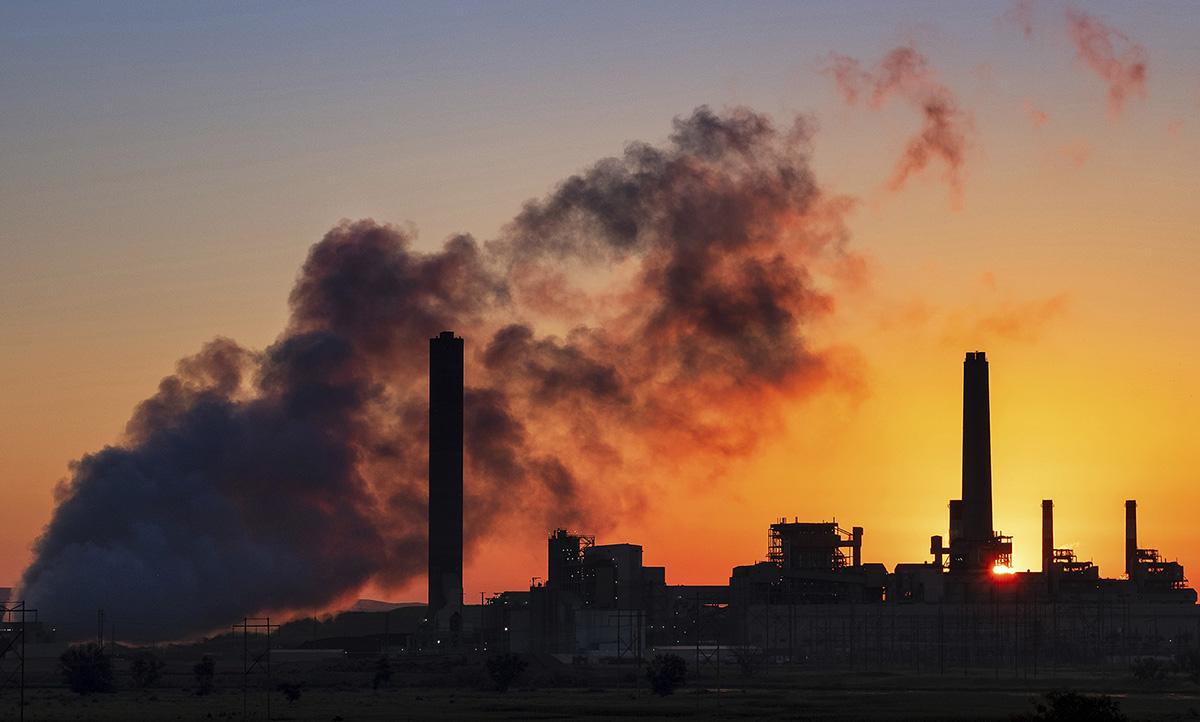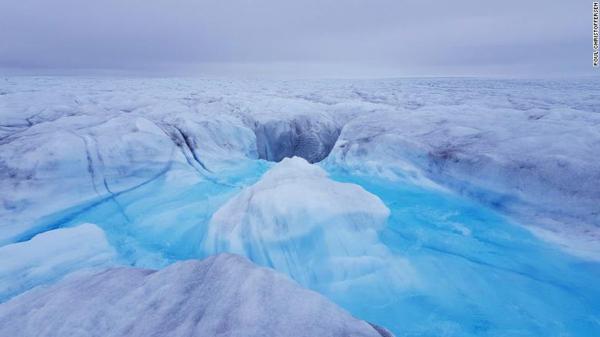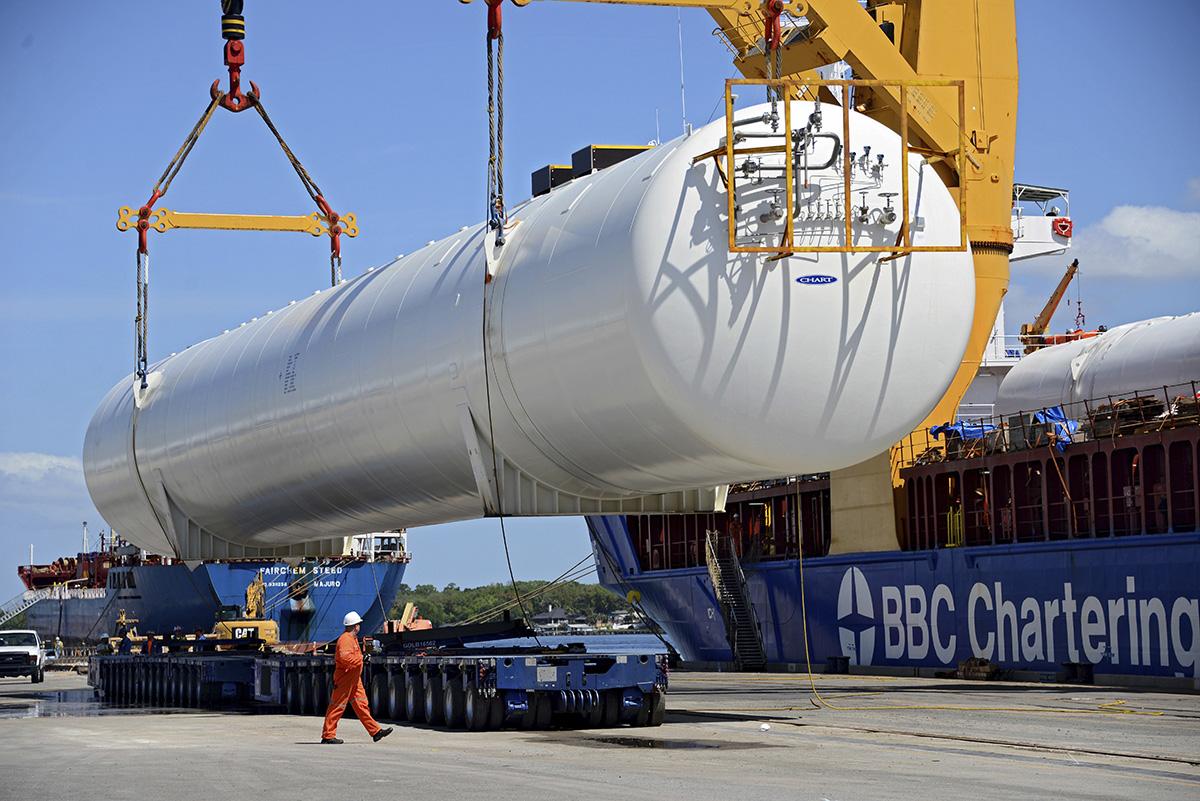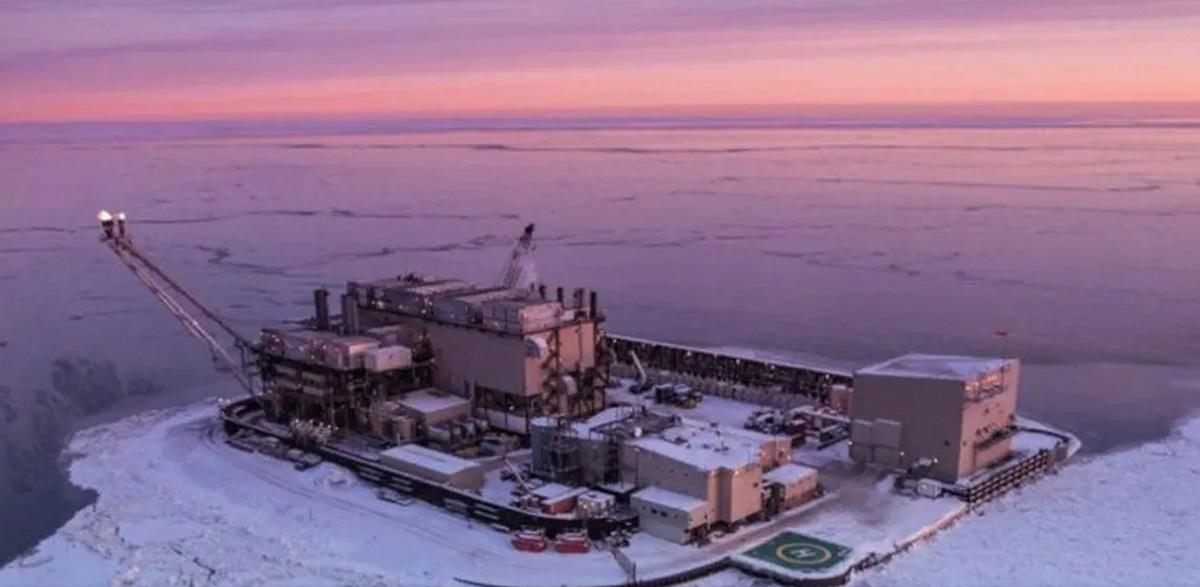
Somali families flee drought stricken area, June 2022. Tens of millions of people are being uprooted by natural disasters due to the impact of climate change. Photo: AP
The world that we know cannot continue in the way it has for decades. Multiple crises—in the relations between nations, in splits between fascist and “liberal” sections of ruling classes, in immigration, in the situation of women (and gender relations more generally), and in the ongoing and intensifying oppression of Black people and people of color—all these are at breaking points. And among the most acute of these crises concerns the environment. In all of these spheres, things are headed for turmoil and upheaval, and a radical resolution.
The question posed to humanity is, as Bob Avakian has put it, whether that resolution will be a reactionary and enslaving one, or a revolutionary and emancipating one. The basis exists to actually get on the road to resolving all of these towards something truly emancipating—and this is true of the climate crisis as well, a point to which we will return.
Yet the deadly illusions of painless progress die hard. And this is where the new climate legislation signed by Biden comes in.
On August 17, President Joe Biden signed into law the Inflation Reduction Act. The legislation contains $369 billion of climate spending measures over the next 10 years. The legislation has been hailed by its Democratic sponsors and its boosters in the mainstream environmental movement as “transformative” and “historic.” The official narrative is that at long last, the U.S. is getting on a trajectory of meeting its obligations to scale back fossil fuel production (oil, natural gas, and coal) and reduce greenhouse gases (carbon and methane that trap heat in the Earth's atmosphere) and set an example for other countries. The U.S. is now said to be on a real transition to a green economy.
There are the triumphalist claims like these; there are also more “measured” responses from some in the environmental community who say that “while the bill is far from perfect, it is at least a start” that could propel the development of solar, wind, and geothermal renewable energy. So we have to examine the actual content of this bill. Because if this truly were a rapid and massive transition to a “green economy,” or a real gateway to that, this would be a good thing for the planet and humanity. This is not the case...
By What Standards and Criteria Do We Evaluate This Bill?

In July 2022, the Supreme Court forbade the EPA from writing sweeping regulations governing carbon dioxide emissions from power plants. Here, the Dave Johnston coal-fired power plant in Glenrock, Wyoming, the top coal-producing state in the U.S. since 1986. Photo: AP
When the Biden climate bill is analyzed and measured against 1) the enormity of the problem of global warming caused by the use of fossil fuels; 2) the outsize role that the U.S. has historically played, and continues to play, in heating up the planet; 3) the scale and speed of measures needed to actually cope with this accelerating crisis; and 4) what is not only necessary but actually possible on the basis of a revolution, and a radically new socialist state power and mode of production, as concretized in the Constitution for the New Socialist Republic in North America, authored by Bob Avakian—it becomes clear that this legislation falls massively and obscenely short of what is needed. Worse, this climate bill actually prolongs the dependency of the U.S. economy on fossil fuels.
In plain words, this bill is part of the problem of global warming, not the solution.
The fact that this takes place at a time in which the old order that brought on this madness is deeply divided, including the ruling class “at war with itself,” and this revolution is much more possible than in “normal” times, makes it all the more criminal.
I. The Big Picture: Accelerating and Intensifying Global Climate Crisis
In February and April of 2022 the United Nations Intergovernmental Panel on Climate Change (IPCC) issued its latest findings on the dire state of the planet and the ominous direction in which things are moving. The reports represent the collaborative efforts of scientists and experts from around the world. They found that 3.3 billion people, over 40 percent of the Earth's population, live in countries with “high human vulnerability” to the effects of climate change.1 That translates as 2 of every 5 people in the world live in the crosshairs of a cascading climate crisis of superstorms, rising seas, catastrophic drought, deadly floods, mass food shortages, and the outbreak of viruses and diseases induced by or exacerbated by climate change. And in different ways, all of the 7.9 billion people on Earth are vulnerable to climate change.

One-third of Pakistan has been flooded by historic monsoon rains June-September 2022. This photo taken September 1, 2022. Photo: AP
The well-established science of global warming shows that, since the capitalist industrial revolution of the late 1700s/early 1800s and creation of fossil-fuel based economies and societies, human beings have heated the planet by an average 1.1 degrees Celsius. The greater part of the carbon in the Earth's atmosphere was emitted since 1950. Climate science points to a looming threshold: if global warming is not limited to 1.5 degrees Celsius (2.7 degrees Fahrenheit, the temperature scale we are accustomed to), we face a likelihood of a catastrophic future. A future that is getting increasingly closer...
A. The Foreboding Summer of 2022

The Arctic is rapidly warming, leading to the faster melting of the Greenland ice sheet, which adds to sea level rise. Photo: Poul Christoffersen
The Arctic is rapidly warming—four times faster than the global average (a much higher rate than earlier scientific studies had projected). This warming leads to the faster melting of the Greenland ice sheet, which adds to sea level rise. The effects of this extend far beyond the Arctic, influencing extreme rainfall and heat waves in the world.
A definitive and ominous measure of the state of global warming: the Arctic's fundamental climate has changed, to one characterized more by liquid water than ice. 2
The summer of 2022 has been one of sustained droughts across the globe: huge swaths of China, South Asia, East Africa, and Europe have been affected. China this year experienced a run of 164 days of extreme temperatures, its worst heat wave on record. In Ethiopia and other parts of East Africa, 20 million people are facing extreme hunger as crops have failed—in some regions of Somalia, it hasn't rained for two years. The planet's changing climate is leading to a situation of extreme water scarcity on the planet that is now projected to force 700 million people to flee their homes in the next decade—from areas stretching from the Middle East, to the Horn of Africa, to the “dry corridor” of Central America. 3
A groundbreaking study published in Environmental Research has determined that air pollution from the burning of fossil fuels is responsible for 1 in 5 deaths worldwide.4
Climate vulnerability is the greatest in the poorest regions of the world, which are the least responsible for this crisis and, precisely because of their poverty and domination by imperialism, the least able institutionally and resource-wise to cope with this crisis.
B. What the Science Tells Us Must Be Done, Capitalist-Imperialist System Says NO
The IPCC reports of this and last year were clear in their message (even as they had to pull some punches under pressure from governments and the fossil-fuel industry). Given the trend lines of temperature rise and its effects on Earth's ecosystems, there is little margin for delay to act to hold global warming to that 1.5 degree tipping point. To act in line with that means slashing carbon emissions as quickly as possible; rapidly phasing out power plants running on fossil fuels; reconfiguring transportation, industry, and other segments of the global economy away from fossil fuels; and reducing total energy demand by 40-70 percent by 2050. These are measures called for by science, reaffirmed in the 2022 IPCC reports, as necessary to avoid catastrophe.
But this is not the direction things are going in! The world is currently on track to produce DOUBLE the amount of coal, oil, and gas in 2030 than would be consistent with preventing warming from rising more than 1.5 degrees. Globally, greenhouse gas emissions rose to a new record in 2021. U.S. carbon emissions increased 6.2 percent last year, largely due to greater use of coal (the dirtiest fossil fuel) for generating electricity. Why? Mainly because natural gas prices rose in 2021 and thus—by the workings and yardsticks of the capitalist market—coal became more “cost efficient.”5
Meanwhile, “climate friendly” Joe Biden has been pressuring and cajoling U.S. oil companies and oil-producing countries (like Saudi Arabia) to ramp up oil production as part of U.S. imperialism's game plan to weaken Russia by supplying America's NATO-West European allies with natural gas and oil. The expansion of fossil fuels and the wider application of related technologies like liquefication of natural gas for global transport have been critical elements of the U.S.'s proxy (indirect) war with Russia. In short, America aims to weaken Russia by turning up the fossil-fuel spigots!
Something is wrong, very wrong, with this picture.
II. How the Biden Climate Bill Prolongs Fossil-Fuel Dependency and Locks in New Carbon Emissions

A liquified natural gas tank in Jacksonville, Florida, is over half a football field long, weighs 260 tons and can store 265,000 gallons of liquified natural gas.
Photo: AP
Consider what would be the single most important policy measure required to confront and act on climate change, especially in the U.S., the world's largest producer of oil and natural gas (and third largest producer of coal)? It would be to bend every effort to wind down and eliminate fossil fuels and to develop an urgent timeline of action in sync with this. This is an existential crisis—whether or not the Earth will be habitable. But comb through the hundreds of pages of the Inflation Reduction Act and you will find NOTHING about phasing out fossil fuels, keeping the oil in the ground. Indeed, the bill facilitates expanded production of fossil fuels.
A. What Is Mandated and What Is Not
*The Biden climate bill does not mandate cuts in carbon emissions but does mandate the auction-leasing of federal lands for new fossil-fuel projects. The climate legislation does not set emissions reductions targets with corresponding enforcement mechanisms. That is supposed to happen on its own—through credits and subsidies from the government that incentivize renewable energy development. Think about it. We are on the precipice of climate catastrophe and running out of time to act. And yet the U.S., the source of more carbon accumulated in the atmosphere than any other country, is unable and unwilling to do something as basic and essential as mandating steep cuts in carbon emissions.
But the bill does mandate something... and it is not very pretty. It requires the U.S. Interior Department each year to offer two million acres of public land and 60 million acres of offshore waters for oil and gas leasing—for fossil-fuel companies to drill in Alaska and the Gulf of Mexico—as a prerequisite for granting rights to solar and wind companies to install utility-scale renewable projects on federal lands and waters. This policy will continue for 10 years!

Drilling for oil in Alaska. Photo: Bureau of Safety and Environmental Enforcement
This is criminal: renewable energy development is tethered and handcuffed to provisions for new investment in fossil-fuel projects. A salient fact: according to the Center for Biological Diversity, fossil-fuel production on federal lands and waters is responsible for close to 25 percent of U.S. greenhouse emissions.6
*The Biden climate bill promotes and rewards a technology that prolongs oil and natural gas production. The bill aims to drive the widespread deployment of “carbon capture and storage” (CCS) technology—stripping carbon emissions from industrial smokestacks or directly from the air and burying them deep underground. This is hailed as a wondrous way to limit carbon pollution. But when this technology and its applications are looked at more closely, a different picture emerges.
To begin with, CCS is a questionable, not yet fully proven, technology. More to the point, one has to ask: why has this technology been championed and invested in by companies like Exxon Mobil, Chevron, and BP? The answer, and it is somewhat shocking, is explained in an important August 10, 2022 essay that appeared in the New York Times:
Where C.C.S. has been most widely used in the United States and elsewhere... is in the production of oil and natural gas. Here's how: Natural gas processing facilities separate carbon dioxide from methane to purify the methane for sale. These facilities then sometimes pipe the “captured” carbon dioxide to what are known as enhanced oil recovery projects, where it is injected into oil fields to extract additional oil that would otherwise be trapped underground. Of the 12 commercial C.C.S. projects in operation in 2021, more than 90 percent were engaged in enhanced oil recovery...7
The authors point out that carbon capture and storage was a “big winner” in Biden's climate bill and that the support for it in the bill amounts to an oil production subsidy “in the name of fighting climate change.” The major fossil-fuel companies support and promote CCS because, if operable, it allows for the continued burning of fossil fuels.
A SIDENOTE OF A FOSSIL-FUEL INDUSTRY HARDLY IN DECLINE: Of the top ten best performing U.S. stocks of the first half of 2022, three were coal producers and five were linked to oil and natural gas.8
B. The Market as an Outmoded and Irrational Mechanism for Organizing Human Society... And the Hour Is Late
The Biden climate legislation is predicated on government incentives and subsidies to private units of capital to spur a modicum of renewable energy development. This is a reflection of the roundabout and indirect mechanisms of capitalism. In a capitalist-imperialist economic and political system—the foundation of which is privately owned, competing blocs of capital that exploit laborers worldwide—there is no society-wide means, no direct mechanism, no governing power to set rational priorities... to allocate resources according to social need and environmental sustainability.
To those who care about the planet, there's no getting around a cold truth about fossil fuels and global warming: To seriously deal with climate change, you would have to put the fossil-fuel companies out of business, seize their assets, and leave most of the fossil fuel in the ground.
And for that to happen, for society to interact with nature in a sustainable way, you need a revolution. A revolution to overthrow this system... to create a new state power and socialize ownership of the means of production... and to forge a planned socialist economy. This is the radically different economic foundation that makes it possible to utilize society’s resources collectively and to unleash people to go to work on the environmental emergency in the interests of world humanity and to have a real chance (not a certainty) to save the planet.
This liberatory socialist revolution is not some fuzzy, far-off prospect. It is more possible in the conditions of today, with multiplying, intensifying, and overlapping social and political crises that can erupt into massive upheaval, with the ruling class of the U.S. “at war with itself.” For people to get caught up in illusory “positives” in the Biden climate bill would be bad enough in normal times. But in these times, such magical thinking is especially harmful. It is to turn away from and to squander the heightened opportunity to make a revolution that could actually transform humanity's relationship to nature.
III. The Misleading Math of Projected Carbon Emission Reductions; A More Accurate Picture of the Carbon Footprint of U.S. Imperialism
A. The Deceptive Hoopla of the New Law's Carbon Emissions Reductions
The passage of Biden's Inflation Reduction Act with its climate provisions has been accompanied by a number of widely-publicized studies showing that the law will, by 2030, reduce U.S. carbon emissions by 40 percent compared with 2005 levels. But this is extremely misleading. The bulk of the projected reductions that the Biden climate bill is taking credit for are actually accounted for by other developments, including the switching over by many U.S. power plants from coal to natural gas, a fossil fuel that emits less carbon but is still contributing greenhouse gases.
So despite the bright lights, the reality is that this legislation will only deliver a 7 to 10 percent carbon reduction relative to ongoing trends.9
And the 40 percent emissions reduction total projected overall is by no means locked in. Don't forget the increase in coal use last year. And even this 40 percent reduction in emissions linked to the new climate legislation and ongoing trends is a retreat from the 50 percent reduction by 2030 that the U.S. has pledged in 2021—a level of reduction which, as we will see, comes nowhere close to the U.S.'s historical responsibility for carbon in the atmosphere. (We will come back to what level of emissions cuts is actually needed and proportionate to the U.S. role in global warming.)
B. America's Outsourcing of Carbon Emissions
There's another serious “accounting problem.” We are dealing with global warming because this is a planetary emergency—heat-trapping gases from the burning of fossil fuels that stay in the Earth's atmosphere. But the calculations and commitments by which countries cost up and carry out carbon reduction plans are defined by country boundaries.
Take a company like General Motors. It has operations around the world: in Europe, Latin America, China and other parts of Asia. These facilities and supply chains that feed into them emit carbon. The worst emissions are in the Third World. This is where U.S. companies take advantage of cheap production costs and lax environmental regulations to enhance their global competitiveness. But the carbon emissions of a company like GM are allocated to its home base in the U.S. When companies import goods (like Apple or Target), the carbon emissions involved in their production overseas are not included in their official carbon footprint.
Here is a “dirty little secret” of U.S. imperialism revealed in an important study by a team of Spanish economists: if you add up the carbon emissions of the foreign affiliates of U.S. transnational corporations—like GM, Ford, Exxon Mobil that operate beyond U.S. borders—and treat this overseas activity as a single entity (as though it were a country unto itself)—that combined total would make that entity the 12th top emitter of carbon in the world!10 Again, this is NOT counted in U.S. emissions and projected cuts in U.S. emissions.
C. America's Genocidal Military and Its Carbon Emissions

The U.S. military is not only the single largest institutional consumer of fossil fuels in the world; it is also the world's single largest institutional emitter of carbon. USAF F35A Lightning IIs fly in formation over Florida. Photo: Wikipedia/USAF
When the world's government leaders met at the last major climate summit in Glasgow in November 2021, the carbon pollution of the world's major militaries was not on the agenda. Indeed, the world's militaries have developed creative ways to conceal and under-report their huge carbon emissions.
The U.S. has the largest military budget of any country in the world—in 2021, the U.S. spent more on its military than the next nine countries combined (including China and Russia).
The U.S. military is not only the single largest institutional consumer of fossil fuels in the world; it is also the world's single largest institutional emitter of carbon. We're talking about overt and covert military operations overseas, the maintenance of military bases and transport systems, the massive global supply chains that serve this military. Every major weapon system—from jet fighters to aircraft carriers—is highly carbon-intensive. The Air Force's F-35A jet fighter burns 2.4 gallons of fuel for every nautical mile. And the constant procurement of new weapons of death locks in certain carbon-intensive technologies for decades.11
Oil plays a strategic role in maintaining and extending America's dominant position in the world capitalist-imperialist system. And as Bob Avakian put it in a spring 2022 interview: “To wildly understate matters, there is no possibility of eliminating, or even reducing, this massive consumption of oil, while this system and its military remains in power and enforces the interests of the capitalist-imperialist ruling class of which it is a highly destructive instrument.”12
D. What Would a Just and Proportionate Reduction of U.S. Carbon Emissions Look Like?
The average person in Bangladesh emits 0.5 metric tons of carbon dioxide per year. In the U.S., that number is 15.2 metric tons per person, or about 30 times(!) as much. Bangladesh is responsible for only a tiny fraction of global carbon emissions. Yet Bangladesh suffers extreme consequences of global warming—rising seas, floods, and intensifying cyclones. These are “climate-change impacts” for which high-emitting, wealthy countries are largely responsible.13
The U.S. has contributed more carbon to the atmosphere than any other country in the world. Among the 10 largest industrialized countries of the world, the U.S. has the highest per person consumption of oil. We have shown how the U.S. is responsible through imperialist globalization for emitting massive amounts of carbon beyond its national boundaries. On top of that, the U.S. and other imperialist countries have privatized and monopolized knowledge and technologies vital for addressing climate change. This monopolization is exercised through patents, licensing, and other controls that weaken the ability of poor countries to gain access to and effectively adapt such technologies.
If we take the historical “carbon debt” of the U.S. along with its current emissions levels, into account; if we proceed from the existential nature of the climate crisis and the measures that need to be taken to massively curtail carbon emissions and rapidly transition towards renewable energy—we would gain a very different, more truthful, understanding of the level of carbon reductions really required of the U.S.
The Climate Equity Reference Project has, with this methodology, calculated that the U.S.'s just share of the global effort to reduce carbon emissions in 2030 to a level that corresponds to the U.S.'s historical and current contribution to global warming “is equivalent to a reduction of 195 percent below [the U.S.'s] 2005 emissions.”14 That's almost five times greater than the projected emissions reductions under Biden's climate legislation.
IV. Is Such a Scale of Carbon Emissions Reductions Possible? Yes, But Not Under This Capitalist-Imperialist System...
Because you would have to restructure the entire economy, transport, industry... you would have to ideologically and morally challenge people, setting out to change existing and environmentally unsustainable patterns of consumption. You would have to do away with this economic system driven by profit and its inner dynamic of expand-or-die: produce more, more cheaply, or the competition will beat you out. You would have to do away with a political system in which climate-denying fascists wield enormous power—in state governments and especially on the Supreme Court which in late May 2022, stripped the Environmental Protection Agency (EPA) of its power to issue and enforce broad pollution and emissions standards.
All of which is to say, you would need to overthrow this system and replace it with a sustainable socialist economy and society whose development would serve the interests of world humanity and safeguarding the planet.
This revolution has been charted by Bob Avakian. The Constitution for the New Socialist Republic in North America sets forth the vision and blueprint for a liberatory new state power and economy empowering people to uproot racism, patriarchy, and other horrors of this system. This is a system of governance that promotes the widest intellectual and cultural ferment, debate, and dissent—contributing to getting at the truth of the world and the pathways to a world without exploitation and oppression, in which people can be fit caretakers of the planet.
Revolution makes it possible to tap immense potential to act on the environmental crisis that is suppressed by this system. This takes in:
—scientific knowledge and technical capabilities that are at hand to convert this planet-destroying economy but which are hemmed in by the drive for profit...
—the many deeply thought through and practical proposals of scientists, engineers, urban planners and others for sustainable energy systems, cities, and transport; the lessons to be scaled-up from practices and knowledges of sustainable agriculture; and so much more—that go nowhere under this system...
—the determination and creativity of people from all walks of life who want to save the planet but who are kept powerless...
—and the unprecedented scale and forms of global cooperation and collaboration which are technically and socially feasible, and essential to truly address and act on what is a planetary crisis, but which cannot take effect in a world system of contending capitalist-imperialist states pursuing national great-power interests, a system in which the ruling classes of a handful of rich capitalist countries dominate the great bulk of humanity.
A socialist revolution that proceeds from the interests of world humanity and that advances globally would break, and set an example for breaking, such fetters and unleashing this suppressed potential.
For how the New Socialist Republic in North America would deal with the problems discussed in this article after the revolution, go to:
- Constitution for the New Socialist Republic in North America, authored by Bob Avakian. (In particular, Article IV. The Economy and Economic Development in the New Socialist Republic in North America, Section 4 on “socialist sustainable development.”)
- Some Key Principles of Socialist Sustainable Development
V. Biden Bill Not a Plan for Decisively Retooling Around Renewable Energy
According to a 2019 study by Wood Mackenzie (a global energy research/consultancy group), the cost of fully “decarbonizing” the U.S. power grid alone, to transform it to be able to produce, deliver, and store renewable energy, would require some $4.5 trillion in investments.15 That sum, which doesn't include all the other things that would need to be transformed for a sustainable economy, is 12 times greater than the $369 billion budgeted for the next 10 years in the Biden climate law (through government credits and subsidies to spur renewable energy development).
So there is a vast disconnect here in terms of the funding really needed. It's not an oversight. Rather, the full-out transition to a green economy is assuredly not the agenda of the Inflation Reduction Act.
There are many reasons for this. They include the fact that the U.S. ruling class is deeply divided, with one section, the Republi-fascists, still, as mentioned, denying the reality and science of climate change—while the fossil-fuel industry has now settled into the tack of denying and blocking genuine climate crisis solutions (while touting bogus “green” aspirations).
There is a defining underlying factor as to why a rapid green transition is “not on the agenda.” The U.S. capitalist-imperialist economy has historically evolved in a certain way. Its industrial system, its infrastructure, its technology depend on fossil fuel. All this capital that has been sunk into the economic structure—including massive fossil-fuel investments in exploring, drilling, refining, etc.—must be profitably recouped by different private blocs of capital. The U.S.'s global supply chains, which pivot on the super-exploitation of labor in the Third World, also depend on fossil fuel.
What this means is that the cost (in that $4.5 trillion range) of making the transition to a full green economy is a prohibitively high barrier relative to the framework and functioning of this system of imperialism. Further, you have this perverse situation in which technological advances in recent years, like hydraulic fracking, have cheapened the production of new sources of shale oil and natural gas, enhancing the profitability and global leverage of U.S. imperialism.
Again, think about the way that the U.S. has turned oil and natural gas into economic weapons in its proxy war with Russian imperialism. Geoeconomic strength founded on fossil fuels is integral and vital to the functioning of the U.S. empire.

VI. Expanding Renewables: Not to Save the Planet But to Strengthen U.S. Imperialism's Ability to Dominate the Planet... and Boost Its Legitimacy
The Biden climate bill is an initiative of the Democratic Party wing of the U.S. ruling class. While the provisions of the bill, as indicated earlier, are still not enough for the United States to meet the U.S.'s 2021 commitment to reduce greenhouse gases 50 percent by 2030, the bill does contain measures to expand renewable energy in the U.S. These measures include promoting the production of and expanding the market for electric vehicles and promoting the development of domestic solar-power manufacturing capacity, as well as wind; and overall bolstering U.S. global market strength in renewables. Again, the mechanisms for doing this are credits and subsidies from the government to lessen “market risk” of private investment in green energy.
The wager of the Biden climate bill is that this will fire up the building out of a larger renewable energy component of the U.S. energy mix on the foundation of the strategic fossil-fuel core of the U.S. economy and empire. This approach has everything to do with “energy security.”
A. Imperialist Energy Security
The mainstream-imperialist think tank Peterson Institute for International Economics, in welcoming the climate bill (while faulting it for not going far enough), explains some of the bill's essential imperial logic:
The climate change legislation... is intended in part to jumpstart US solar manufacturing—fabrication and assembly of materials across the solar value chain—and provide greater energy security by reducing U.S. reliance on Chinese solar suppliers.... The current situation is a significant source of US strategic vulnerability.16
Notice that the governing concept is “energy security,” not “environmental sustainability." Energy security refers to issues of fossil-fuel and renewable-fuel production capacity, cushioning against price shocks and bottlenecks in and interruptions of supply chains, and, crucially, preventing global energy competitors from securing dominance. While sections of the U.S. ruling class recognize the reality and dangers of global warming to the habitability of the planet—this is seen through the lens of threats to security, stability, U.S. competitiveness, and global dominance. The Pentagon has issued many studies warning of the disruptive potential of climate change—migrations, local resource wars, great-power competition for shrinking shares of raw materials, and more.
Solar and wind energy account for only 10 percent of the world's electricity generation.17 But this share is growing. And strength in solar and wind power is fast becoming a lever of market control and geoeconomic advantage in the evolving imperialist world order in which China is a rising capitalist-imperialist power.
B. U.S.-China Imperial Rivalry and Renewables
China is mounting a serious economic, political, and military challenge to U.S. imperialism. Right now solar energy is the cheapest source of green energy, and China has a commanding lead in solar production. It controls some 80 to 85 percent of world solar production, and solar manufacturing costs are 20 percent lower in China than in the U.S. China dominates all stages of solar panels—including mining of key raw materials to make photovoltaic cells that convert sunlight into energy. Large parts of the world economy are dependent on China to supply critical building blocks for solar energy. China's global production networks for wind turbines and solar panels stretch across Asia, Africa, and Latin America.18
*The U.S. share of solar component shipments worldwide fell to less than 1 percent in 2021 from 13 percent in 2004.19 The U.S. has relied on, and continues to rely on, market protectionism to wage its economic battle with China. It has applied tariffs (like a tax) and placed sanctions on solar panels from China, limiting and blocking their entry into the U.S. (thus making importing renewables more expensive). This is to enhance the U.S.'s competitive position. In 2021, 80 percent of all solar panels installed in the U.S. were imported from Cambodia, Thailand, Malaysia, and Vietnam.20
The U.S. imperialists are aiming to increase manufacturing capacity for solar panels in the U.S., both through these economic protectionist measures and by providing financial incentives to domestic U.S. manufacturers. The climate bill requires U.S. automakers, as a condition for subsidies, to obtain high percentages of their battery materials for electric cars from the United States and “free trade” partners of the U.S., like Mexico and Canada that are part of the U.S.'s larger economic bloc.21
*China and the U.S. are engaged in a contest in Africa for control over and access to lithium and cobalt supplies (for electric batteries) and other raw materials. All of which is anchored to savage, superexploitation in mines and processing facilities. China has the upper hand in control over raw materials.
*China is highly dependent on imported oil to meet its domestic needs. The U.S., on the other hand, has a competitive advantage in fossil-fuel capacity—as the world's largest producer of oil and natural gas, along with its strategic fossil-fuel relations with Canada, Mexico, and Saudi Arabia.
*The U.S. and China are the world's two largest economies. They are the world's two largest carbon emitters, currently accounting for more than 40 percent of global greenhouse emissions. These two capitalist-imperialist powers are on a collision course economically and, increasingly, militarily. Both have ratcheted up naval and air maneuvers, as well as combat exercises, in the South China Sea and Taiwan Strait. Nancy Pelosi's July 2022 visit to Taiwan was a deliberate and calculated provocation. In this setting, bilateral climate talks between the two countries collapsed in the summer of 2022.
At a time when international collaboration and cooperation would be essential to deal with a crisis that threatens ecosystems and life on this planet... what we see instead, especially between the U.S. and China, is growing competition, confrontation, and disengagement. This is bound up with the nature of imperialism: rivalry and contention over markets, technologies, resources, and regions... and wars for greater empire.
Think about it, renewable energy is an object of trade wars. Think about it, global summits like the Glasgow climate conference of November 2021 are arenas to advance vying imperialist agendas. Think about it, the U.S. and other imperialist powers have, since 2010, fallen far short in carrying through on pledges made at these summits to provide financial assistance for climate-change mitigation measures for countries of the Global South already suffering horrific consequences of global warming. While the planet heats up, as sea levels rise.
"The Destruction of the Planet by Capitalism-Imperialism," by Bob Avakian, an excerpt from Why We Need an Actual Revolution and How We Can Really Make Revolution.
C. A Gambit to Establish U.S. Climate Legitimacy
The idea that the United States is a global leader on climate change is a joke—like trying to portray the U.S. as a world leader in the fight against racist police murder. The U.S. never backed the Kyoto Protocol of 1992, the world's first international treaty to commit countries to reducing greenhouse emissions. With its superpower swagger, it has made clear that it will not accept climate constraints on itself. In the opening days of the Paris climate conference of 2015, Obama lifted export controls on U.S. oil, an arrogant slap in the face. And not long after, Trump said fuck you to the planet and pulled the U.S. out of the Paris Climate Agreement.
The world sees the U.S. as a country that has made next to no progress on substantially limiting carbon emissions (indeed, it was in the 2010s that the U.S. became the world's largest oil and natural gas producer).
While this stance has protected America's “right to pollute,” it has also made it difficult for the U.S. to claim any “high moral ground” in its diplomacy and bullying, including “naming and shaming” others. China, on the other hand, has gotten considerable diplomatic mileage out of exposing U.S. hypocrisy and inaction while advertising its clean-energy initiatives—financial support by the Chinese state for China's renewable energy sector is far greater than the Biden climate bill. (Not that anyone should be seduced by China's imperialist public relations... it has plans for 169 new and expanded coal projects, deepening its reliance on this fossil fuel.)22
Among other things, the Inflation Reduction Act is an attempt by the U.S. to present itself on the world stage as a “climate leader.” How many times have you heard it said that the U.S. has enacted its “biggest ever climate law”? True, but the bar is very low, as the U.S. government has assiduously done practically nothing over the decades since the famous appearance of scientist James Hansen before Congress in 1989 summarizing the irrefutable facts of global warming.
The new climate legislation gives the U.S. some diplomatic clout (like the civil rights legislation of the 1960s) while at the same time, and more importantly, it provides political cover for the bigger failure of the U.S. to act commensurately with this existential crisis. Something else: the U.S. imperialists are selling this new climate law in part as a way to reassure and maintain the loyalty of those millions who have awakened to the nightmare of rapid climate change and who are agonizing about what to do.
VII. Conclusion and Challenge: There Is a Way Out
By way of summation, let me repeat the paragraph at the start of this article about standards and criteria for evaluating the climate provisions of the Inflation Reduction Act:
When the Biden climate bill is analyzed and measured against 1) the enormity of the problem of global warming caused by the use of fossil fuels; 2) the outsize role that the U.S. has historically played, and continues to play, in heating up the planet; and 3) the scale and speed of measures needed to actually cope with this accelerating crisis; and 4) what is not only necessary but actually possible on the basis of a revolution, and a radically new socialist state power and mode of production, as concretized in the Constitution for the New Socialist Republic in North America, authored by Bob Avakian, it becomes clear that this legislation not only falls massively and obscenely short of what is needed. Worse, this climate bill actually prolongs the dependency of the U.S. economy on fossil fuels. In plain words, this bill is part of the problem of global warming, not the solution.
That is the case, with supporting evidence, that has been made here. There are many climate scientists, environmental activists and thinkers and others who, while they might agree with aspects of this analysis, have reached a different conclusion. In their view, this legislation is “at least a start... and something is better than nothing.”
The answer to the argument that “something is better than nothing” is that this is in fact a “devil's choice.” Because this “something” is precisely the “building out of a greater component of renewable energy in the U.S. energy mix on the foundation of the strategic fossil-fuel core of the U.S. economy and empire.”
*This Biden bill is NOT the needed transition to a green economy.
*It is NOT a program of cooperation and collaboration with the people of the world.
*This supposed “something” (that is better than nothing) is a project of imperialist empire—at a time when the danger of imperialist nuclear war and ever-more existential cascading effects of climate change is growing.
*In sum, this new climate legislation is not a collection of some good and bad things but rather is a coherently imperialist bill in all its aspects.
The real and fundamental choice before us is this: either we allow this capitalist-imperialist system to hurtle humanity and the planet to catastrophe... or we make revolution.
Let's go back to what is actually required to confront and act on the climate emergency, against the backdrop of the current, capitalist-imperialist, system.
Can anyone seriously imagine this system “mandating” that some of the largest and most powerful corporations in the world, the fossil-fuel industry, must now exit from this activity? Or that leading U.S. banks, like Chase and Citi, that are among the 60 global financial institutions that invested over $700 billion(!) in the fossil-fuel industry in 2021 must simply write all that off as a loss?23
Can anyone seriously imagine this system dismantling the fracking and off-shore drilling, the refineries, the pipelines, and transforming the almost, two-cars-per-household lifestyle and culture in this country, the list goes on, with the economic landslide that would set off? And dismantle its military that straddles the globe?
And if your answer is “no” but you can't seriously imagine a revolution that WOULD be able to do that... then you've not seriously studied the work of the revolutionary leader Bob Avakian, who has deeply and thoroughly set forth how revolution guided by the new communism would be able to do this. And why this revolution is now more possible.
“...we have two choices: either, live with all this—and condemn future generations to the same, or worse, if they have a future at all—or, make revolution!”
—Bob Avakian
Hope on a Scientific Basis
It's a big problem in society that in the face of the enormity of the climate crisis, too many people veer between hopelessness (“it's too late to act”) and illusory hope (the system will “come to its senses”). Both are variations on bowing to the capitalist-imperialist system and the disastrous trajectory it has put us on.
But there is a real alternative, there is “hope on a scientific basis.”
Bob Avakian has scientifically determined that we are in a “rare time” when revolution becomes more possible in the U.S.—and why this is so. Crucially, he has analyzed how the U.S. ruling class has become more divided than at any time since the Civil War—and the implications of this for revolution. Because you can't make revolution at just any time. He has developed a “road map,” a concrete strategy, for making revolution in this rare time. And that depends on people waking up to, being challenged to becoming part of and contributing to this revolution.
Bob Avakian has produced deep and fine-grained analyses of this juncture marked by multiple crises in immigration and displacement of people across the planet; in the situation of women (and gender relations more generally); in the ongoing and intensifying oppression of Black people and other people of color—all of these, and acutely so with global warming, reaching breaking points.
Step back again. We live in a world in which more than 100 million people have been displaced—owing to persecution, wars, poverty, and climate change.24 That's 1 in every 78 people on Earth forced to flee—what the UN calls “a dramatic milestone that few would have expected a decade ago.” This global refugee crisis, global warming that knows no boundaries... never have the borders of the world been more archaic.
There is huge possibility opening up to break through with revolution in the country that has brought more suffering to the people of the world than any other... that has caused more destruction to the planet than any other. There is huge possibility opening up to break through with revolution in a country with highly developed productive forces and technology that could, on the basis of creating a whole new socialist economic and social-political system, be utilized for the betterment of humanity and the repair of the planet.
There is no guarantee of revolution, but there IS this heightened possibility “in the belly of the beast.” As Avakian has put it, “a serious fight for revolution in this country—this country—would have the effect of a powerful political earthquake, sending seismic shockwaves throughout the world.”
A potentially historic moment like this is not a moment to waste. There is a world to win and a planet to save.
FURTHER READINGS
Something Terrible, OR Something Truly Emancipating: Profound Crisis, Deepening Divisions, The Looming Possibility Of Civil War—And The Revolution That Is Urgently Needed, A Necessary Foundation, A Basic Roadmap For This Revolution
Constitution for the New Socialist Republic in North America
Some Key Principles of Socialist Sustainable Development
Interview with Bob Avakian

